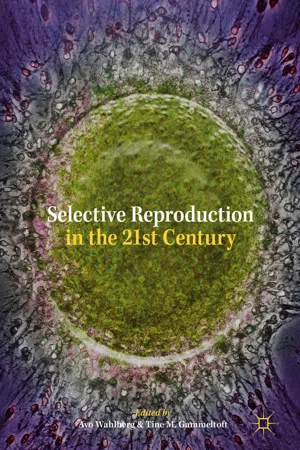Objective of selection | Type of selection (SRT) | Scope |
|---|---|---|
Selecting for desired sex (sex selection) | • Sex-selective abortion following prenatal determination of foetal sex • Sex-selective implantation of embryos following in vitro fertilization (IVF) and embryo biopsy (PGD) • Sex-selective fertilization of gametes following the MicroSorting® of sperm cells in a semen sample based on the chromosome they are carrying (can only influence sex of embryo) | Sex-selective abortion is legally prohibited in most countries of the world. Nevertheless, millions of especially female foetuses are aborted annually around the world. In countries like China, India and Vietnam, obstetric ultrasound has contributed to unprecedented sex ratios at birth as high as 120 boys for every 100 girls. While sex-selective abortion is often considered to be a problem of the so-called Global South linked to son preference, sex-selective fertilization of gametes or implantation of embryos (as opposed to abortion) is often described as ‘family balancing’ or ‘lifestyle’ sex selection in the Global North. While prohibited in some countries, thousands of cycles of MicroSort® insemination and PGD for sex-selective purposes are carried out each year globally |
Selecting for a healthy/normal child (prevention of disease/disability) | • Selective abortion of foetuses following detection of ‘serious’ foetal abnormality, chromosomal disorder or genetic disease • Selective implantation of only unaffected/healthy embryos following IVF and embryo biopsy (PGD) • Sex-selective fertilization of gametes following the MicroSorting® of sperm cells in a semen sample based on the chromosome they are carrying (can only influence sex of embryo) in order to avoid transmitting a sex-linked genetic disease • Selective fertilization of gametes following medical screening of gamete donors to prevent transmission of infectious or genetic disease | Prenatal screening programmes have been routinized throughout the world covering millions of women (there are an estimated 213 million pregnancies globally every year, not all are screened) involving combinations of maternal serum screening, free foetal DNA screening, obstetric ultrasound scans and invasive prenatal diagnosis. Legislation varies with some countries allowing for late-term abortions if a ‘serious’ condition is detected. Such terminations remain controversial in many countries and there is no consensus as to what conditions (if any) are considered serious enough to warrant an abortion. Following the detection of foetal abnormalities, chromosomal disorders or genetic diseases/conditions, hundreds of thousands of pregnancies are terminated annually (legally and illegally) around the world (there are an estimated 45 million induced abortions globally every year; we estimate between 0.2 and 1 % of abortions are on grounds of substantial risk that the child would be seriously affected if the pregnancy is not terminated). Thousands of cycles of MicroSort® insemination and/or PGD are carried out around the world to prevent transmission of a genetic disease. |
Selecting for desired traits (donor selection) | • Selective fertilization of gametes following the choosing of a suitable gamete donor based on available information about donor health, eye colour, hair colour, blood type, height, intelligence, beauty, race/ethnicity, and so on • Selective implantation of embryos with disabilities by parents with disabilities (e.g., deafness or dwarfism) | Sperm banks and egg brokers screen thousands of potential gamete donors every year. Of these, between 10 and 20% are selected as qualified donors according to screening criteria. Legislation varies with some countries prohibiting all gamete donation and others allowing infertile couples, single women and/or lesbian and gay couples to access donor gametes. Studies have shown that infertile heterosexual couples are mostly concerned with health and less concerned with traits while gay couples, lesbian couples and single women often select for traits that are familiar to them and their families. Hundreds of thousands of donor babies have been born worldwide, the first major cohort of which (born in the 1980s) is now actively seeking out donor siblings and their biological fathers or mothers |
Selecting for saviour siblings (HLA matching) | • Selective implantation of histologically compatible embryos following IVF, embryo biopsy and HLA (human leukocyte antigen) typing (using PGD) in order to treat a sick sibling | Hundreds of saviour siblings have been created using PGD throughout the world starting in the USA in 2000. Using PGD to create saviour siblings remains controversial (because of concerns about the welfare and instrumentalization of the saviour child) and not all countries allow it |

Selective Reproduction in the 21st Century
- English
- ePUB (mobile friendly)
- Available on iOS & Android
Selective Reproduction in the 21st Century
About This Book
This book explores how conditions for childbearing are changing in the 21st century under the impact of new biomedical technologies. Selective reproductive technologies (SRTs) - technologies that aim to prevent or promote the birth of particular kinds of children – are increasingly widespread across the globe. Wahlberg and Gammeltoft bring together a collection of essays providing unique ethnographic insights on how SRTs are made available within different cultural, socio-economic and regulatory settings and how people perceive and make use of these new possibilities as they envision and try to form their future lives. Topics covered include sex-selective abortions, termination of pregnancies following detection of fetal anomalies during prenatal screening, the development of preimplantation genetic diagnosis techniques as well as the screening of potential gamete donors by egg agencies and sperm banks. This is invaluable reading for scholars of medical anthropology, medical sociologyand science and technology studies, as well as for the fields of gender studies, reproductive health and genetic disease research.
Frequently asked questions
Information
1. Introduction: Kinds of Children
Table of contents
- Cover
- Frontmatter
- 1. Introduction: Kinds of Children
- 1. Sex Selection
- 2. Preventing Disease and Disability
- 3. Selecting Traits
- Backmatter